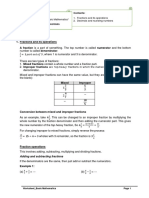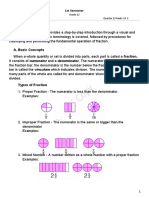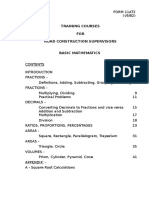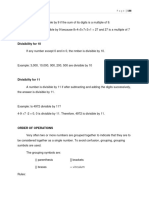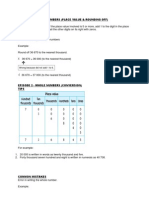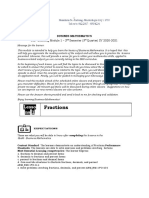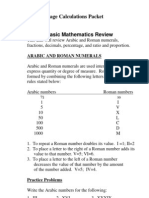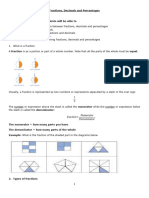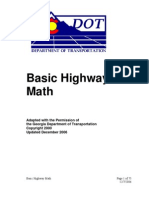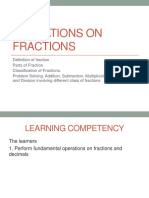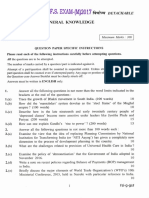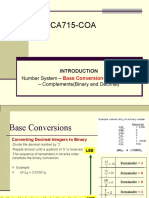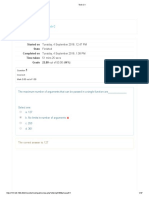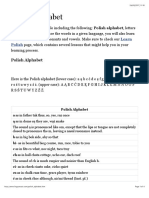Core 1-01
Core 1-01
Uploaded by
jyoprasadCopyright:
Available Formats
Core 1-01
Core 1-01
Uploaded by
jyoprasadOriginal Title
Copyright
Available Formats
Share this document
Did you find this document useful?
Is this content inappropriate?
Copyright:
Available Formats
Core 1-01
Core 1-01
Uploaded by
jyoprasadCopyright:
Available Formats
1.
01 - BASIC MATHEMATICS & ALGEBRA RCT STUDY GUIDE
LEARNING OBJECTIVES:
1.01.01 Add, subtract, multiply, and divide fractions.
1.01.02 Add, subtract, multiply, and divide decimals.
1.01.03 Convert fractions to decimals and decimals to fractions.
1.01.04 Convert percent to decimal and decimal to percent.
1.01.05 Add, subtract, multiply, and divide signed numbers.
1.01.06 Add, subtract, multiply, and divide numbers with exponents.
1.01.07 Find the square roots of numbers that have rational square roots.
1.01.08 Convert between numbers expressed in standard form and in scientific notation.
1.01.09 Add, subtract, multiply, and divide numbers expressed in scientific notation.
1.01.1 Solve equations using the "Order of Mathematical Operations".
1.01.2 Perform algebraic functions.
1.01.3 Solve equations using common and/or natural logarithms.
INTRODUCTION
Radiological control operations frequently require the RCT to use arithmetic and algebra to
perform various calculations. These include scientific notation, unit analysis and conversion,
radioactive decay calculations, dose rate/distance calculations, shielding calculations, stay-time
calculations. A good foundation in mathematics and algebra is important to ensure that the data
obtained from calculations is accurate. Accurate data is crucial to the assignment of proper
radiological controls.
-1- Issued 05/95
1.01 - BASIC MATHEMATICS & ALGEBRA RCT STUDY GUIDE
SYMBOLS FOR BASIC OPERATIONS
The four basic mathematical operations are addition, subtraction, multiplication and division.
Furthermore, it is often necessary to group numbers or operations using parenthesis or brackets.
In writing problems in this course the following notation is used to denote the operation to be
performed on the numbers. If a and b represent numbers or variables, the operations will be
denoted as follows:
Table 1. Symbols for Basic Mathematical Operations
Operation Notation
Addition: a+b
Subtraction: a b
Multiplication: a×b a b a(b) ab
a
Division: a÷b a/b ba
b
Grouping: ( ) [ ]
Equality: =
Inequality:
Less than: < Less than or equal to:
Greater than:
> Greater than or equal to:
-2- Issued 05/95
1.01 - BASIC MATHEMATICS & ALGEBRA RCT STUDY GUIDE
1.01.01 Add, subtract, multiply and divide fractions.
FRACTIONS
Whole numbers are the normal counting numbers and zero.
{0, 1, 2, 3, 4...}
A fraction is part of a whole number. It is simply an expression of a division problem of two
whole numbers. A fraction is written in the format:
a
or a/b
b
The number above the bar a is called the numerator and the number below the bar b is called the
denominator. A proper fraction is a fraction in which the number in the numerator is less than the
number in the denominator. If the numerator is greater than the denominator
then it is an improper fraction. For example, ½ and ¼ are proper fractions, while 7 , 5 , 5 , or 61
5 5 1 27
are improper fractions.
Any whole number can be written as a fraction by letting the whole number be the numerator and
1 be the denominator. For example,
5 2 0
5 2 0
1 1 1
Five can be written as 10/2, 15/3, 20/4, etc. Similarly, the fraction ¼ can be written as 2/8, 3/12,
4/16, etc. These are called equivalent fractions. An equivalent fraction is built up by multiplying
the numerator and the denominator by the same nonzero number. For example,
3 32 6 3 35 15
4 42 8 4 45 20
A fraction is reduced by dividing the numerator and the denominator by the same nonzero
number. For example,
12 12 ÷2 6 6 6 ÷3 2
18 18 ÷2 9 9 9 ÷3 3
-3- Issued 05/95
1.01 - BASIC MATHEMATICS & ALGEBRA RCT STUDY GUIDE
A fraction is reduced to lowest terms when 1 is the only number that divides both numerator and
denominator evenly. This is done by finding the greatest common multiple between the
numerator and denominator1. In the previous example, two successive reductions were
performed. For the fraction 12/18, the greatest common multiple would be 6, or (2 × 3), which
results in a reduction down to a denominator of 3.
A whole number written with a fraction is called a mixed number. Examples of mixed numbers
would be 1½, 3¼, 5¾, etc. A mixed number can be simplified to a single improper fraction using
the following steps:
1. Multiply the whole number by the denominator of the fraction
2. Add the numerator of the fraction to the product in step 1.
3. Place the sum in step 2 as the numerator over the denominator.
For example:
(5 4) 3 23
53
4 4 4
Adding and Subtracting Fractions
In order to add and subtract fractions the denominators must be the same. If the denominators
are not the same, then the fractions must be built up so that the denominators are equal.
-4- Issued 05/95
1.01 - BASIC MATHEMATICS & ALGEBRA RCT STUDY GUIDE
Same Denominator
To add two fractions that have the same denominator:
1. Add the numerators
2. Place the sum of step 1 over the common denominator
3. Reduce fraction in step 2 to lowest terms (if necessary)
For example,
1 3 1 3 4
5 5 5 5
Subtraction of two fractions with the same denominator is accomplished in the same
manner as addition. For example,
5 3 5 3 2 2÷2 1
8 8 8 8 8÷2 4
Different Denominator
To add two fractions with different denominators requires that the equations be built up so
that they have the same denominator. This is done by finding the lowest common
denominator. Once a common denominator is obtained, the rules given above for the
same denominator apply.
For example, 1/3 + 2/5. The fraction 1/3 could be built up to 2/6, 3/9, 4/12, 5/15, 6/18,
7/21, etc. The fraction 2/5 could be built up to 4/10, 6/15, 8/20, 10/25, etc. The lowest
common denominator for the two fractions would be 15. The problem would be solved as
follows:
1 2 15 23 5 6 5 6 11
3 5 35 53 15 15 15 15
Subtraction of fractions with different denominators is accomplished using the same steps
as for addition. For example,
3 2 33 24 9 8 9 8 1
4 3 43 34 12 12 12 12
-5- Issued 05/95
1.01 - BASIC MATHEMATICS & ALGEBRA RCT STUDY GUIDE
Multiplying and Dividing Fractions
Multiplication of fractions is much easier than addition and subtraction, especially if the
numbers in the numerators and denominators are small. Fractions with larger numerators
and/or denominators may require additional steps. In either case, the product of the
multiplication will most likely need to be reduced in order to arrive at the final answer. To
multiply fractions:
1. Multiply the numerators
2. Multiply the denominators.
3. Place product in step 1 over product in step 2.
4. Reduce fraction to lowest terms.
For example:
5 3 15 15÷3 5
6 4 24 24÷3 8
A variation on the order of the steps to multiply fractions is to factor the numerators and
denominators first, reduce and cancel, and then multiply. An example follows:
3 20 3 225 3/ 2/ 2/ 5 5 5
8 9 222 33 2 2/ 2/ 3/ 3 23 6
Reciprocals
Two numbers whose product is 1 are called reciprocals, or multiplicative inverses. For
example:
1 1
5 and are reciprocals because 5 · = 1.
5 5
4 5 4 5
and are reciprocals because · = 1.
5 4 5 4
1 is its own reciprocal because 1 · 1 = 1.
0 has no reciprocal because 0 times any number is 0 not 1.
-6- Issued 05/95
1.01 - BASIC MATHEMATICS & ALGEBRA RCT STUDY GUIDE
1
The symbol for the reciprocal, or multiplicative inverse, of a nonzero real number a is .
a
Every real number except 0 has a reciprocal. We say, therefore, for every nonzero real
number a, there is a unique real number 1 such that
a
1
a 1
a
Now, look at the following product:
1 1 1 1
(ab)( · ) (a · )(b· ) 1 · 1 1
a b a b
Relationship of multiplication to division
The operation of division is really just inverted multiplication (reciprocals). Notice from
the first examples given on the previous page that the reciprocal of a fraction is merely
"switching" the numerator and denominator. The number 5 is really 51-, and the reciprocal
of 5 is 1 . Likewise, the reciprocal of 2 is 3 , which can also be expressed as:
5 3 2
1 2 3 3
1÷ 1·
2 3 2 2
3
Fractions are a division by definition. Division of fractions is accomplished in two steps:
1. Invert the second fraction, i.e. change it to its reciprocal, and change the division
to multiplication.
2. Multiply the two fractions using the steps stated above.
For example:
4 2 4 3 12 12÷2 6
÷
7 3 7 2 14 14÷2 7
-7- Issued 05/95
1.01 - BASIC MATHEMATICS & ALGEBRA RCT STUDY GUIDE
Practice Problems
Solve the following problems involving fractions. Answers should be reduced to lowest
terms.
1. 1/3 + 2/3 2. 5/7 - 3/7
3. 5/9 + 2/3 4. 6/7 - 1/2
5. 2 - 1/3 6. 3/8 + 15/16
7. 25/32 - 3/4 8. 15/21 - 4/7
9. 13/20 - 2/5 10. 7/18 + 5/9
11. 2/3 × 1/5 12. 4/7 × 3/4
13. 1/2 × 2 14. 3/5 × 4
15. 4/9 ÷ 2/3 16. 8/13 × 2/3
17. 12/15 × 3/5 18. 20/25 ÷ 4/5
19. 7/8 × 2/5 20. 14/21 ÷ 2/7
1.01.02 Add, subtract, multiply and divide decimals.
DECIMALS
A decimal is another way of expressing a fraction or mixed number. It is simply the numerical
result of divison (and fractions are division). Recall that our number system is based on 10
("deci" means ten) and is a place-value system; that is, each digit {0, 1, 2, 3, 4, 5, 6, 7, 8, 9} in a
numeral has a particular value determined by its location or place in the number. For a number in
decimal notation, the numerals to the left of the decimal point is the whole number, and the
numerals to the right are the decimal fraction, the denominator being a power of ten.
Figure 1. Decimal Place Value System
-8- Issued 05/95
1.01 - BASIC MATHEMATICS & ALGEBRA RCT STUDY GUIDE
For example, the numeral 125.378 (decimal notation) represents the expanded numeral
3 7 8
100 20 5
10 100 1000
If this numeral were written as a mixed number, we would write it as:
378
125
1000
Addition and Subtraction of Decimals
In order to add or subtract decimals use the following steps:
1. Arrange the numbers in a column so that the decimal points are aligned.
2. Add or subtract in columns from right to left. (Additional zeros may need to be
added to the right of the subtrahand.)
3. Place the decimal point in the answer in line with the other decimal points.
For example:
21.3 654.200
4.2 26.888
25.5 627.312
Multiplying Decimals
To multiply decimal numbers, do the following:
1. Multiply the numbers as if there were no decimal points.
2. Count the number of decimal places in each number and add them together.
3. Place the decimal point in the product so that it has the same number of decimal
places as the sum in step 2.
-9- Issued 05/95
1.01 - BASIC MATHEMATICS & ALGEBRA RCT STUDY GUIDE
For example:
5.28 0.04
× 3.7 × 0.957
3696 0.03828
1584
19.536
Division of Decimals
The steps for division of decimals are as follows:
1. Move the decimal point of the divisor to the right until it becomes a whole number.
2. Move the decimal point of the dividend to the right the number of places moved in step 1.
3. Divide the numbers as if they were whole numbers.
For example:
28
0.25 7.00
50
2 00
2 00
0
Decimal Forms
As we have learned, decimals are the result of division (or a fraction). When the remainder
of the division is zero, the resulting decimal is called a terminating or finite decimal. For
example, fractions like 2/5, 3/8 and 5/6 will all result in finite decimals. These fractions
and the resulting decimals are known as rational numbers.
On the other hand, fractions like 1/3, 2/7, 5/11 and 7/13 result in a nonterminating or
infinite decimal. For example, 2/7 results in the decimal 0.285714286 . . . , the dots
meaning that the decimal continues without end. These numbers are known as irrational
numbers. Note that even though irrational numbers are nonterminating, some, such as 1/3
and 5/11 are repeating or periodic decimals because the same digit or block of digits
repeats unendingly. For example:
-10- Issued 05/95
1.01 - BASIC MATHEMATICS & ALGEBRA RCT STUDY GUIDE
1 5
0.3333 . . . 0.454545 . . .
3 11
A bar is often used to indicate the block of digits that repeat, as shown below:
1 5
0.3̄ 0.4̄5̄
3 11
Practice Problems
Solve the following problems involving decimals.
1. 0.23 + 3.4 2. 5.75 2.05
3. 6.1 1.6 4. 0.018 + 0.045
5. 468.75 192.5 6. 2.3 × 3.2
7. 0.007 × 2.18 8. 5.2 ÷ 1.4
9. 12.26 ÷ 0.04 10. 4.0 × 0.25
1.01.03 Convert fractions to decimals and decimals to fractions.
FRACTION TO DECIMAL CONVERSION
To convert a fraction to a decimal we simply perform the operation of division that the fraction
represents. For example, the fraction 3/4 represents "3 divided by 4", and would be converted
as follows:
0.75
4 3.00
28
20
20
0
-11- Issued 05/95
1.01 - BASIC MATHEMATICS & ALGEBRA RCT STUDY GUIDE
Practice Problems
Convert the following fractions to decimals.
1. 1/2 2. 2/5
3. 5/8 4. 12/25
5. 13/39 6. 7/16
Convert the following decimals to fractions. Reduce answers to lowest terms.
7. 0.125 8. 0.6666
9. 4.25 10. 0.2
1.01.04 Convert percent to decimal and decimal to percent.
PERCENT
Percentage is a familiar concept. Most people know the meaning of terms such as 100 percent
and 50 percent. Percentage is such a convenient concept for expressing common and decimal
fractions that it is widely used. The word percent actually means "out of a hundred." (Consider
that there are 100 "cents" in a dollar, and that a "century" is 100 years.) A percent is simply a
fraction whose denominator is 100. Thus, 50 percent means 50/100 or 0.50, while 25 percent
means 25/100 or 0.25.
Percent is abbreviated by the symbol %. So, 75 percent is written 75%.
Converting Decimal to Percent
A decimal fraction is changed to a percent by moving the decimal point two places to the
right and adding a percent sign. For example, 18- equals 0.125. Therefore:
0.125 12.5%
A percent is changed to a common fraction by omitting the percent sign, placing the
number over 100, and reducing the resulting fraction if possible. For example, 32% equals
32/100 which reduces to 8/25. When the percent consists of a mixed decimal number with
a percent sign, the resulting fraction will contain a mixed decimal numerator. This can be
-12- Issued 05/95
1.01 - BASIC MATHEMATICS & ALGEBRA RCT STUDY GUIDE
changed to a whole number by multiplying the numerator and the denominator by 10, 100,
1,000, etc.
Percentage is most frequently used to indicate a fractional part. Thus 20% of the total
power output for 75% of the employees refer to fractional parts of some total number. To
perform arithmetic operations with a percent, it is normally changed to a common or
decimal fraction. Usually, a decimal fraction is more convenient.
Converting Percent to Decimal
A percent is changed to a decimal fraction by omitting the percent sign and moving the decimal
point two places to the left. For example:
48% 0.48 *
*
Thus, 92% equals 0.92, 8% equals 0.08, and so on. *
Practice Problems
Convert the following decimals to percent.
1. 0.5 2. 0.782
3. 1.1 4. 0.06
5. 0.049 6. 0.0055
Convert the following percentages to decimals.
7. 65% 8. 0.25%
9. 300% 10. 0.09%
-13- Issued 05/95
1.01 - BASIC MATHEMATICS & ALGEBRA RCT STUDY GUIDE
1.01.05 Add, subtract, multiply and divide signed numbers.
SIGNED NUMBERS
The numbers that are used to describe the number of objects in a group, the counting numbers,
are always positive numbers; that is, they are always greater than zero. However, there are many
occasions when negative numbers, numbers less than zero, must be used. These numbers arise
when we try to describe measurement in a direction opposite to the positive numbers. For
example, if we assign a value of +3 to a point which is 3 feet above the ground, what number
should be assigned to a point which is 3 feet below the ground? Perhaps the most familiar
example of the use of negative numbers is the measurement of temperature, where temperatures
below an arbitrary reference level are assigned negative values.
Every number has a sign associated with it. The plus (+) sign indicates a positive number; the
minus ( ) sign indicates a negative number. When no sign is given, a plus sign is implied. The
fact that the plus and minus signs are also used for the arithmetic operations of addition and
subtraction should not be a cause for confusion, for we shall see that they have equivalent
meanings.
Every number has an absolute value, regardless of its sign. The absolute value of a number is
indicated by a pair of vertical lines enclosing the number: *5*. The absolute value indicates the
distance from zero, without regard to direction. The number 5 is 5 units from zero, in the positive
direction. The number 5 is also 5 units from zero, but in the negative direction. The absolute
value of each of these numbers is 5.
Operations with Signed Numbers
The arithmetic operations of addition, subtraction, multiplication, and division of signed
numbers can be more easily visualized if the numbers are placed on a number line (see
Figure 2). The positive numbers are greater than zero, and they lie to the right of zero on
the number line. The negative numbers are less than zero, and lie to the left of zero on the
number line.
FIGURE 2. Number Line
-14- Issued 05/95
1.01 - BASIC MATHEMATICS & ALGEBRA RCT STUDY GUIDE
The number line extends an infinite distance in each direction and therefore includes all
numbers. The process of addition can be considered as counting in one direction or the
other from a starting point on the number line. For example, let us add 1 + 2. We locate
+1 on the number line and then count 2 units to the right, since we are adding +2. The
result will be +3. To illustrate further, let us add +2 and 4. We first locate +2 on the
number line and then count 4 units to the left. We end up at 2.
The number line is useful for illustrating the principles of addition, but it clearly would be
inconvenient to use in the case of large numbers. Consequently, the following rules were
developed to govern the addition process:
Adding and Subtracting Signed Numbers.
To add two numbers with the same signs, add their absolute values and attach the
common sign. For example:
( 3) + ( 2) = 5
To add two numbers with opposite signs, find the difference of their absolute values, then
attach the sign of the original number which had the greater absolute value. For example:
( 2) + 3 = 1
Notice that 3 and +3 are the same distance but in opposite directions from 0 on the
number line. What happens when you add two numbers like 3 and 3?
3 + ( 3) = 0
7+7=0
If the sum of two signed numbers is 0, the numbers are called additive inverses or
opposites.
For example: 7 3=4 is the same as: 7 + ( 3) = 4
8 2=6 is the same as: 8 + ( 2) = 6
So, it can be seen that subtracting a number is equivalent to adding its additive inverse or
opposite.
-15- Issued 05/95
1.01 - BASIC MATHEMATICS & ALGEBRA RCT STUDY GUIDE
To subtract a signed number, add its opposite or additive inverse. In other words,
change the subtraction symbol to addition and change the sign of the second signed
number. For example:
5 ( 8) = 5 + (+8) add +8
6 11 = 6 + ( 11) add 11
4 ( 7) = 4 + (+7) add +7
Multiplying and Dividing Signed Numbers.
The product of two numbers with like signs is a positive number. The product of two
numbers with unlike signs is a negative number. In symbols:
(+) × (+) = (+) (+) × ( ) = ( )
( ) × ( ) = (+) ( ) × (+) = ( )
For example:
( 4) × ( 3) = (+12)
( 4) × (+3) = ( 12)
The division of numbers with like signs gives a positive quotient. The division of
numbers with unlike signs gives a negative quotient. In symbols:
(+)/(+) = (+) (+)/( ) = ( )
( )/( ) = (+) ( )/(+) = ( )
For example:
( 24)/( 6) = (+4)
( 24)/(+6) = ( 4)
Remember that multiplication is really a short form of addition. When we say +4 × ( 3),
we are adding the number 3 four times, that is, ( 3) + ( 3) + ( 3) + ( 3) = 12. Also,
since division is a short form of subtraction, when we say 24 ÷ ( 6), we subtract the
number 6 from the number 24 four times in order to reach 0, i.e.,
24 ( 6) ( 6) ( 6) ( 6) = 0. Although we could repeat the process for the
multiplication and division of any signed numbers, usage of the two rules will produce
equivalent results.
-16- Issued 05/95
1.01 - BASIC MATHEMATICS & ALGEBRA RCT STUDY GUIDE
Practice Problems
Solve the following problems involving signed numbers.
1. ( 28) + ( 51) 2. ( 2) + ( 5)
3. 40 + ( 21) 4. ( 87) + 50
5. 48 + ( 27) 6. 56 ( 5)
7. 81 4 8. 48 ( 2)
9. ( 4)(5) 10. 6/( 3)
11. 4 ( 5) 12. ( 6)/( 3)
13. ( 6)/3 14. ( 8)( 5)
15. ( 7)(6)
1.01.06 Add, subtract, multiply and divide numbers with exponents.
EXPONENTS
An exponent is a small number placed at the right and a little above another number, called the
base, to show how many times the base is to be multiplied by itself. Thus, 34 (read "three to the
fourth power") means 3 used as a factor four times or 3 × 3 × 3 × 3. 4 is the exponent; 3 is the
base.
In general, if a is any real number and n is any positive integer, the nth power of a is written an, *
where a is the base and n is the exponent, is read as "a to the nth power," and tells you that a is *
used as a factor n times. *
Thus, 52 is called "5 raised to the second power" (or 5 "squared"), and 23 is called "2 raised to the
third power" (or 2 "cubed"). When no exponent is shown for a number or no power is indicated,
the exponent or power is understood to be 1. Thus, 7 is the same as 71. Any number raised to
the power of zero equals one; that is, 70 = 1. Normally, exponents of zero and one are not left as
the final value, but are changed to the simpler form of the base.
Exponents can be expressed as integers as in the examples above or as fractions or decimals such
as 91/2 or 103.2. They may also be positive or negative.
-17- Issued 05/95
1.01 - BASIC MATHEMATICS & ALGEBRA RCT STUDY GUIDE
Exponents and powers are particularly useful in mathematics not only because they shorten the
writing of mathematical expressions but also because they simplify many mathematical operations.
However, there are several special rules which govern mathematical operations involving numbers
with exponents.
Addition and Subtraction
The addition or subtraction of numbers with exponents can be performed only if both the
bases and the exponents of the numbers are the same. When the bases of the exponents
are different, the multiplication indicated by the exponent must be performed and the
numbers then added or subtracted. Thus, 25 and 24 cannot be added directly because their
exponents are different. They can be added only by carrying out the indicated
multiplication first. Thus, 25 equals 2 × 2 × 2 × 2 × 2 which equals 32, and 24 equals 2 × 2
× 2 × 2 which equals 16. Therefore, 25 + 24 equals 32 + 16 which equal 48.
When the bases and the exponents are the same, the numbers can be added or subtracted
directly. Thus,
35 + 35 = 2(35) = 2(243) = 486
Multiplication
The multiplication of numbers with exponents of the same base is performed by adding the
exponents. The general form is as follows:
(am)(an) = am+n
It is important to remember that the bases of the numbers must be the same before they
can be multiplied by adding their exponents. The base of the product is the same as the
base of the two factors. Thus,
32 × 33 = 35 = 243
-18- Issued 05/95
1.01 - BASIC MATHEMATICS & ALGEBRA RCT STUDY GUIDE
Division
The division of numbers with exponents of the same base is performed by subtracting the
exponent of the divisor (numerator) from the exponent of the dividend (denominator).
The general form is:
am
am n
n
a
Again, it is important to remember that the bases of the numbers must be the same before
they can be divided by subtracting their exponents. The base of the quotient is the same as
the base of the number divided. Thus,
25
25 2
23 8
2
2
Division of numbers with exponents can be used to show why any number raised to the
power of zero equals one. We know that any fraction in which the numerator equals the
denominator can be reduced to 1; that is, 2/2 = 1. Similarly:
23
23 3
20 1
3
2
Exponent Raised to a Power
Raising a number with an exponent to a power is performed by multiplying the exponent
by the power. The general form is:
(am)n = amn
The base of the answer is the same as the base of the number raised to the power. Thus:
(52)2 = 52×2 = 54 = 625
-19- Issued 05/95
1.01 - BASIC MATHEMATICS & ALGEBRA RCT STUDY GUIDE
Product Raised to a Power
Raising a product of several numbers to a power is performed by raising each number to
the power. The general form is as follows:
(ab)n = anbn
Thus:
[(2)(3)(4)]2 = (22)(32)(42) = (4)(9)(16) = 576
This same result can also be obtained like this:
[(2)(3)(4)]2 = 242 = 576
Mixed Product and Exponents Raised to a Power
The same rule can be used to raise a product of several numbers with exponents to a
power. The general form looks like this:
(AaBbCc)n = Aa×nBb×nCc×n
Thus:
[(2)4(3)3(4)2]2 = (24×2)(33×2)(42×2) = (28)(36)(44) = (256)(729)(256)
Fraction Raised to a Power
Raising a fraction to a power is performed by raising both numerator and denominator to
the power. It should be remembered that with a proper fraction (numerator is less than
the denominator) the resulting number must be less than one. Also, the resulting number
will be less than the value of the original fraction. Thus, (2/3)3 equals 23/33 which equals
8/27, which is also less than one and less than the original fraction, 2/3.
-20- Issued 05/95
1.01 - BASIC MATHEMATICS & ALGEBRA RCT STUDY GUIDE
Negative Exponents and Powers
A negative exponent or power has a special meaning. Any number, except 0, with a
negative exponent equals the reciprocal of the same number with the same positive
exponent. For example:
2 1 1
6
62 36
The same rules for addition, subtraction, multiplication, division and raising to a power
apply to negative exponents that apply to positive exponents. However, in adding,
subtracting or multiplying the exponents, the rules for signed numbers must also be
observed.
Fractional Exponents
Fractional exponents are used to represent roots (see next section). The general form of a
m
n
fractional exponent is a , which reads "the nth root of am." For example, a½, means the
square root of a1, or a. In other words, a½ = a .
Calculator Method
To raise a number to a power using a scientific calculator, use the following steps:
1) Enter the number. (Fractions must first be converted to decimal form.)
2) Press the y x key
3) Enter the power. (Fractions must first be converted to decimal form.)
4) Press the key. The number displayed will be the number entered in step 1
raised to the power entered in step 3.
Practice Problems
1. (32)(33)
2. 75/73
3. (105)(106)
4. (106)(10-4)
5. 6-4/6-3
6. 6-8/63
-21- Issued 05/95
1.01 - BASIC MATHEMATICS & ALGEBRA RCT STUDY GUIDE
1.01.07 Find the square roots of numbers that have rational square roots.
SQUARE ROOTS
To square a number means to multiply the number by itself, i.e. raise it to the second power.
(Consider that a square is two-dimensional.) For example, 2 squared is 4, since 2 × 2 = 4. The
square of 3 is 9, 4 squared is 16, and so on.
Just as subtraction "undoes" addition and division "undoes" multiplication, squaring a number can
be "undone" by finding the square root. The general definition is as follows:
If a2 = b, then a is a square root of b.
Be careful not to confuse the terms square and square root. For example, if 52 = 25, this
indicates that 25 is the square of 5, and 5 is the square root of 25. To be explicit, we say that it
is a perfect square because 5 times itself is 25.
All perfect squares other than 0 have two square roots, one positive and one negative. For
* example, because 72 = 49 and ( 7)2 = 49, both 7 and 7 are square roots of 49. The symbol ,
referred to as the radical, is used to write the principal, or positive, square root of a positive
number.
49 7 is read "The positive square root of 49 equals 7."
A negative square root is designated by the symbol .
49 7 is read "The negative square root of 49 equals 7."
It is often convenient to use plus-or-minus notation:
± 49 means the positive or negative square root of 49.
Therefore, the rule is that every positive real number a has two square roots: a and a . It
follows from the definition of square root that ( a)2 a, and that a 2 a . Because the square
of every real number is either positive or zero, negative numbers do not have square roots in the
set of real numbers.
-22- Issued 05/95
1.01 - BASIC MATHEMATICS & ALGEBRA RCT STUDY GUIDE
Notice that 4 25 100 10 and 4 25 2 5 10 . Therefore, 4 25 4 25.
Therefore, in general, we can say:
For any nonnegative real numbers a and b: a b a b
a a
It also follows that
b b
Calculator Method
To calculate the square root of any number using a scientific calculator, follow these steps:
1) Enter the number. (Fractions must first be converted to decimal form.)
2) Press the x key. The number displayed will be the square root of the number
entered in step 1. An alternate method is to press the y x key and then type 0.5.
This raises the number in step 1 to the power of 0.5, or ½.
Other roots
For informational purposes only, we mention the fact that other roots may be found for a
number. One of these is the cube root. To cube a number means to multiply the number
by itself three times, i.e. raise it to the third power. (Consider that a cube is three-
dimensional.) For example, 2 cubed is 8, since 2 × 2 × 2 = 8. The cube root (or third
root) of a number, then, is the number that, when raised to the third power (cubed), equals
3
the first number. The notation for a cube root is a .
Note that any root may be taken from a number to "undo" an exponent, such as the fourth
or fifth root. The general definition for a root is:
If an = b, then a is the nth root of b.
n
The notation for the nth root is a . These roots follow the same general rules as the
square root.
-23- Issued 05/95
1.01 - BASIC MATHEMATICS & ALGEBRA RCT STUDY GUIDE
Practice Exercises
Find the indicated square roots.
1. 16 2. 81
3. 144 4. 152
5. ( 6)2 6. 400
1
7. 8. 9 49
64
81
9. 10. 625
36
1.01.08 Convert between numbers expressed in standard form and in scientific
SCIENTIFIC NOTATION
The difficulty in writing very large or very small numbers in the usual manner is that a large
number of zeros are required to write these numbers. This difficulty is overcome by using
scientific notation, in which integral powers of ten are used instead of a large number of zeros to
indicate the position of the decimal point. In addition to simplifying the writing of very large or
very small numbers, scientific notation identifies clearly the number of significant digits in a
number and simplifies arithmetic calculations involving multiplication, division or raising to a
power. For these reasons, it is good practice to write numbers in scientific notation when these
operations are involved.
-24- Issued 05/95
1.01 - BASIC MATHEMATICS & ALGEBRA RCT STUDY GUIDE
The following demonstrates how the number 1 million can be represented by various factors of
10:
0.00001 × 1011
0.0001 × 1010
0.001 × 109
0.01 × 108
0.1 × 107
1,000,000 = 1 × 106
10 × 105
100 × 104
1000 × 103
10,000 × 102
100,000 × 101
1,000,000 × 100
10,000,000 × 10-1
100,000,000 × 10-2
Converting From Standard Form To Scientific Notation
There are two steps involved in writing a number in scientific notation.
1) Move the decimal point just to the right of the first significant digit. The first
significant digit is the first nonzero digit counting from the left.
2) Indicate multiplication of the resulting number by a power of ten that makes its
value equal to the original value. The power of ten is found by counting the
number of places the decimal point was moved from its original position. If
counted to the left, the power is positive; if counted to the right, it is negative. For
example:
Suppose you want to express a number such as 700 in scientific notation.
700 = 7 × 102
Suppose you want to express 0.0014 in scientific notation.
0.0014 = 1.4 × 10-3
-25- Issued 05/95
1.01 - BASIC MATHEMATICS & ALGEBRA RCT STUDY GUIDE
Converting from Scientific Notation to Standard Form
To transform from scientific notation to standard form, follow the opposite procedure.
1.96 × 105 = 196000
2.27 × 10-2 = 0.0227
There are two parts of a number written in scientific notation, the significant digits and
the power of ten. Thus, in the number 3.21 × 106, 3, 2, and 1 are the significant digits and
106 is the power of ten.
The ability to clearly see the number of significant digits can be helpful in performing
arithmetic calculations. For example, the number of significant digits which should be
reported in the product of two numbers can be readily determined if the two numbers are
first written in scientific notation.
When numbers are expressed in scientific notation, calculations can be more easily
visualized. This is because they involve only numbers between 1 and 10 and positive and
negative integral powers of ten which can be treated separately in the calculations using
the rules for numbers with exponents.
1.01.09 Add, subtract, multiply, and divide numbers expressed in scientific
Addition and Subtraction Using Scientific Notation
Addition and subtraction cannot normally be performed directly using scientific notation
because they require adding or subtracting digits of equal place value. Thus, when
numbers expressed in scientific notation are to be added or subtracted, they must first be
converted to forms having equal place value. This is commonly done by expressing them
as numbers which are multiplied by the same integral power of ten. The sum or difference
of these significant digits, multiplied by their common power of ten, is the sum or
difference of the original numbers.
-26- Issued 05/95
1.01 - BASIC MATHEMATICS & ALGEBRA RCT STUDY GUIDE
For example: (3.54 × 105) + (2.51 × 104)
3.54 × 105 is first changed to 35.4 × 104
35.4 × 104
2.51 × 104
37.91 × 104 3.79 × 105
Multiplication and Division Using Scientific Notation
Multiplication or division of numbers using scientific notation is performed by multiplying
or dividing the significant digits and the powers of ten separately. The significant digits
are multiplied or divided in the same manner as other mixed decimals. The powers of ten
are multiplied or divided by adding or subtracting their exponents using the rules for
multiplication and division of numbers with exponents. Thus,
(2.7 × 102)(3.1 × 10-3) = (2.7)(3.1) × (102)(10-3) = 8.37 × 10-1
which should be rounded off to 8.4 × 10-1.
One of the most useful applications of scientific notation is in arithmetic calculations which
involve a series of multiplications and divisions. The use of scientific notation permits
accurate location of the decimal point in the final answer. For example:
Perform the following calculation using scientific notation.
(219)(0.00204)
(21.2)(0.0312)
1) Write each term in scientific notation.
(2.19 ×102)(2.04 ×10 3)
(2.12 ×101)(3.12 ×10 2)
2) Multiply and divide the significant digits.
(2.19)(2.04) 4.46
0.675
(2.12)(3.12) 6.61
-27- Issued 05/95
1.01 - BASIC MATHEMATICS & ALGEBRA RCT STUDY GUIDE
3) Multiply and divide the powers of ten by adding and subtracting exponents.
(102)(10 3) 10 1
1 1
10 100
1 2 1
(10 )(10 ) 10
4) Combine the results.
0.675 × 100 = 6.75 × 10-1
"E" Notation
An alternate method for annotating scientific notation is often used by pocket calculators,
computers and some references. The method uses an E in place of the "× 10," and the
number written after the E is the exponent of 10. The standard and alternate methods for
scientific notation are equivalent and can be converted from one form to another without a
change in value. The expressions below use both methods in equivalent expressions.
3.79 ×105 = 3.79E5
4.02 ×10-6 = 4.02E-6
5.89 ×100 = 5.89E0
Using "E" Notation with a Calculator
Numbers in scientific notation are entered into a scientific calculator as follows:
1) Enter the significant digits.
2) Press the E or EXP key. (Actual key label may vary.)
3) Enter the power of 10. If the power is negative press the / key in conjunction
with entering the power.
Practice Problems
1. (2 × 10 2)(3 × 10 2)
2. (6 × 10 8)/(3 × 103)
3. (9 × 104)( 1 × 10 2)
4. (3 × 10 7)(9 × 102)
5. (7E2)(6E4)
6. (5E 3)/(5E 2)
-28- Issued 05/95
1.01 - BASIC MATHEMATICS & ALGEBRA RCT STUDY GUIDE
1.01.10 Solve equations using the "Order of Mathematical Operations".
ORDER OF MATHEMATICAL OPERATIONS
In solving any equation it is necessary to perform the operations in the equation in accordance
with a certain hierarchy or order of operations. Equations are solved by simplifying operations of
higher order first, according to group, left to right. The order for solving equations is as follows:
1) Simplify expressions within grouping symbols, beginning with the innermost set if
more than one set is used.
2) Simplify all powers.
3) Perform all multiplications and divisions in order from left to right.
4) Perform all additions and subtractions in order from left to right.
For example: (3 + 1)2 × 3 14 ÷ 2
1) Simplify parentheses.
(3 1)2 × 3 14 ÷ 2
2) Simplify powers.
(4)2 × 3 14 ÷ 2
3) Perform multiplication and 16 × 3 14 ÷ 2
division left to right.
4) Perform subtraction. 48 7
5) Final answer: 41
Practice Problems
1. 5 + ( 3) ( 2) 6 2. 18 [52 ÷ (7 + 6)]
3. 19 7 + 12 2 ÷ 8 4. 23 20 ÷ 4 + 4 3
5. 10 + 6(0.5)3 6. 33 + 10 ÷ 5
7. (8 + 4 3)2 8. 7(42 10) ÷ (12 ¾)
9. 7(6 22) 10. (57 25)½
-29- Issued 05/95
1.01 - BASIC MATHEMATICS & ALGEBRA RCT STUDY GUIDE
1.01.11 Perform algebraic functions.
ALGEBRA
Algebra is the branch of mathematics which deals with the manipulation of words and letters, generically
called symbols, which represent numbers. Two factors contribute to the widespread use of algebra in
scientific calculations. First, by using words and letters to represent the values of physical quantities, physical
relationships can be expressed in clear, concise, and completely generalized form. Second, by using words
and letters in place of numbers, combinations of physical relationships may be simplified to yield results
applicable to any set of numbers.
For example, the area of a rectangle equals the product of the length of the rectangle multiplied by its width.
In generalized terms, this statement can be written as:
Area = Length × Width
This expression is a simple rule which tells the relationship between the area and the length and width of a
rectangle. It does not mean that words are multiplied together but rather that numbers are inserted for the
length and the width to obtain the area. For example, if the length is 4 feet and the width is 2 feet, the area is
2 × 4 feet or 8 square feet. This expression can be further simplified by using symbols or letters instead of
words. For example, if area is designated by the letter A, length designated by the letter l, and width
designated by the letter w, the following expression results:
A = l × w or A = lw
In algebraic expressions, when two or more letters representing numbers are written next to each other
without a symbol between them, multiplication is indicated.
Variables vs. Numbers
When words or letters are used to represent numbers, they are called variables. Thus, when x, y, z, f
or k are used to represent the values of physical quantities, they are called variables because their
value varies with the actual numbers they may be chosen to represent. In the area calculation above,
A, l, and w are variables used to represent the numerical values of area, length and width, respectively.
-30- Issued 05/95
1.01 - BASIC MATHEMATICS & ALGEBRA RCT STUDY GUIDE
Properties of Variables
Recall that every number has a sign and an exponent associated with it. Recall also that any number
can be written as a fraction by putting that number as the numerator and 1 as the denominator, e.g. 5
= 5-.
1 These properties also apply to any symbols that we might use to represent numbers.
Additionally, a symbol by itself stands for one of whatever the variable represents. That is to say, the
symbol a by itself means "one of the variable represented by the letter a", or 1a. Combining this with
the other "invisible" properties mentioned, the symbol a is understood to represent "positive one of
the variable represented by the letter a to the power of one, over 1", which would be expressed as:
1a 1
1
An expression that is either a numeral, a variable or the product of a numeral and one or more
variables is called a monomial. A combination or sum of monomials is called a polynomial.
Examples of each are:
Monomials: 12 z r -4x3
Polynomials: 3x + 9 6a2 15
Equations
An equation is a statement that two quantities or expressions are equal. The two quantities are
written with an equal sign (=) between them. For example,
1+1=2 10 = 6 ( 4)
5 × 3 = 15 18 ÷ 2 = 9
are all equations because in each the quantity on the left side is equal to the quantity on the right side.
In algebra we use variables to represent numbers in equations. In this lesson we will manipulate and *
solve equations involving more than one varialbe, but we will find the solution, i.e. the final answer, *
to equations having only one variable. *
-31- Issued 05/95
1.01 - BASIC MATHEMATICS & ALGEBRA RCT STUDY GUIDE
Algebraic Manipulation
The basic principle or axiom used in solving any equation is: whatever operation is performed on
one side of an equation)be it addition, subtraction, multiplication, division, raising to an
exponent, taking a root)it must also be performed on the other side if the equation is to remain
true. This principle MUST be adhered to in solving all types of equations.
This axiom can be thought of by visualizing the balancing of a scale. If the scale is initially balanced,
it will remain balanced if the same weight is added to both sides, if the same weight is removed from
both sides, if the weights on both sides are increased by the same factor, or if the weights on both
sides are decreased by the same factor.
Here are the general forms for algebraic manipulation of equations. For the real numbers a, b, c and
n:
Table 2. Rules for Algebraic Operations
Addition: If a = b, then a + c = b + c
Subtraction: If a = b, then a c=b c
Multiplication: If a = b, then a c = b c
Division: If a = b, then a ÷ c = b ÷ c
Involution: If a = b, then an = bn
n n
Evolution: If a = b, then a b
-32- Issued 05/95
1.01 - BASIC MATHEMATICS & ALGEBRA RCT STUDY GUIDE
Manipulating and Solving Linear Equations
The addition or subtraction of the same quantity from both sides of an equation may be accomplished
by transposing a quantity from one side of the equation to the other. Transposing is a shortened way
of applying the addition or subtraction axioms. Any term may be transposed or transferred from one
side of an equation to the other if its sign is changed. Thus, in the equation below the +4 can be
transposed to the other side of the equation by changing its sign:
5x + 4 = 14
5x = 14 - 4
5x = 10
Transposing also works with multiplication and division. Remembering that any number can be
expressed as a fraction we can rewrite the last line of the equation above. We can then move the 5 in
the numerator of the left side to the denominator of the right side:
5x 10
1 1
x 10
1 5
10
x
5
x 2
Some linear equations may contain multiple terms (monomials) involving the same variable. In order
to simplify the equation like terms must be combined. Don't forget those "invisible properties of
variables." Here's an example:
3x 5=x+3 To solve for x:
3x 5 x=x+3 x Subtract x from both sides.
2x 5 = 3 Combine like terms and cancel.
2x 5 + 5 = 3 + 5 Add 5 to both sides.
2x = 8 5 and +5 cancel.
2x 8 Divide both sides by 2.
2 2
x=4 2 over 2 cancels. Reduce.
-33- Issued 05/95
1.01 - BASIC MATHEMATICS & ALGEBRA RCT STUDY GUIDE
Quadratic Equations
In manipulating an equation involving multiple variables, the "variable of interest" must be moved to
one side of the equal sign and all other variables must be moved to the other side. In order to
accomplish this, operations must be performed on both sides of the equation that will result in a
variable, or group of variables, to be canceled out from one side. This cancellation can only occur if
the "opposite function" is performed on a function that already exists on that side of the equation.
This means that a variable that is being multiplied can be canceled by dividing by the same variable.
Addition can be canceled with subtraction, multiplication with division, etc.
For example: a+b=c To solve for a:
a+b b=c b Subtract b from both sides
a=c b +b and b cancel
Another example: ab = c To solve for a:
ab c Divide both sides by b
b b
c b over b cancels
a
b
Do not forget that the order of operations must be observed when manipulating equations. Otherwise
a completely different solution may result. The key is to do the opposite function in reverse order.
Here is an example which shows how this is done.
a b To solve for a:
d
c
(a b) Multiply both sides by c.
c d c
c
a b dc c over c cancels.
a b b dc b Subtract b from both sides.
a dc b b b cancels
Once the order of the arithmetic functions has been established, manipulation of the formula can
begin. In the example above, if the values for a, b and c were known, the first step would be to add b
to a. The second step would be to divide by c. Therefore, in order to solve it, we do the opposite
functions in reverse order. So, we first multiply by c. Then, we would subtract b. It is a good idea
to rewrite the equation each time so that the operations can be reevaluated before the next step.
-34- Issued 05/95
1.01 - BASIC MATHEMATICS & ALGEBRA RCT STUDY GUIDE
One final example: ab 2 cd 2 To solve for d:
ab 2 cd 2 Divide both sides by c.
c c
ab 2 c over c cancels.
d2
c
Take the square root of both sides.
ab 2
d2
c
Square root of square cancels.
ab 2
d
c
The above example involves the equation known as the inverse
square law and will be seen again in Lesson 1.11.
Substitution
Linear equations are solved by combining like terms and reducing to find the solution. Quadratic
equations are solved by substituting given values into the equation for all but one of the variables,
thus making it a linear equation. The best approach is to first solve for the variable of interest by
algebraic manipulation. Then find the solution by substituting the given values into the equation for
the respective variables. The single, unkown variable, or the variable of interest, will be left on one
side, being set equal to the solution. For example:
Given the equation 2x y2 = 3a - b, that x = 5, y = (-4) and a = 3, solve for b:
2x y2 = 3a - b To solve for b:
2
2x y + b = 3a - b + b Add b to both sides, and cancel.
2x y2 + b = 3a b + b cancels.
2
b = 3a 2x + y Transpose 2x y2 to right side.
2
b = 3(3) 2(5) + ( 4) Substitute known values.
b = 9 10 + 16 Perform operations.
b = 15 Simplify.
-35- Issued 05/95
1.01 - BASIC MATHEMATICS & ALGEBRA RCT STUDY GUIDE
Practice Problems
Solve for the unknown variable:
1. x + 3 = 10 2. 5+z=8
3. y 4. r
2 6
4 2
5. 5(j + 5) = 45 6. 5d = 25
7. 9n2 = 81 8. a + 6 6a = 14
Solve for a:
9. a2b = c2d 10. b c
a d
Substitute the values given and simplify the expression.
11. 3x + 14y xy where x = 5, y = 2
12. 4s 1 where s = 3, t = 10
6t s
13. 16a 5b where a = 1, b = 5
1 4a
14. j where k = 2, j = 12, solve for i
3i 0
1 k
15. 7(2m ¾n) + l = 10 where m = ½, n = 8, solve for l
1.01.12 Solve equations using common and/or natural logarithms.
LOGARITHMS
In many cases, arithmetic operations can be performed much more quickly if the numbers involved are
numbers with exponents to the same base. For example, the multiplication or division of numbers with
exponents to the same base can be performed by merely adding or subtracting the exponents. Raising to a
power or taking a root can be performed by merely multiplying or dividing the exponents by the power or
root. It is this feature of numbers with exponents which led to the development of logarithms. If all numbers
could be readily written as numbers with exponents to the same base, multiplication, division, raising to
powers and taking roots could be performed much more quickly.
-36- Issued 05/95
1.01 - BASIC MATHEMATICS & ALGEBRA RCT STUDY GUIDE
Any number can be expressed as a power of any other number. For example, 64 equals 26, 43, or 82. 64 also
equals 72.137 or 101.806. The use of logarithms involves expressing numbers as powers of a common number,
such as 10, so that arithmetic operations with these numbers can be performed more quickly.
Simply put, a logarithm is an exponent. More explicitly, the logarithm of a number n is the exponent x of a
given base a that is required to produce that number. The symbol loga is used to denote taking a logarithm.
The base is usually indicated by a small number written to the right and slightly below the symbol log. The
general relationship and form are as follows:
If n = ax, where a > 0 and a 1, then: loga n = x
For example:
1000 = 103 log101000 = 3
This says that the base ten logarithm of 1000 is 3, which means that the base number, 10, must be raised to
the power of 3 to equal 1000.
Here are some additional examples:
23 = 8 log2 8 = 3
43/2 = 8 log4 8 = 3/2
Before the development of the scientific calculator, the use of logarithms saved considerable computation
time. For example, the evaluation of the following expression by hand would take a very long time.
(865)3(0.0247)½(93,800)
(0.00186)(4.53)2
However, using logarithms the above expression could be evaluated in a matter of minutes. Thus,
logarithms, or logs, became one of the most useful tools in mathematics. In addition to simplifying arithmetic
calculations and shortening computation time, logs are also important in engineering applications. The
relationship between a number and its logarithm is used frequently to assist in measuring physical quantities
when they vary over a wide range. For example, logarithmic scales are used to measure the neutron flux in
nuclear reactors. Logarithms are also used for scales on charts and meters.
-37- Issued 05/95
1.01 - BASIC MATHEMATICS & ALGEBRA RCT STUDY GUIDE
Properties of Logarithms
Since logarithms are exponents, the basic rules of exponents can be used to develop several useful
properties of logarithms. Suppose that a, x and y are numbers, and a is a suitable base for a logarithm
(a > 0, a 1). The product rule for exponents says:
ax ay = ax + y
Let us say that: u = ax and v = ay
If we write each of these in logarithmic form we would have:
x = loga u and y = loga v
Then: u v = ax ay = ax + y
If we write this in logarithmic form it would be:
loga (u v) = x + y
If we substitute the values for x and y from above we have:
loga (u v) = loga u + loga v
This results in one of the rules for logarithms, the product rule. Using similar methods, we could
also prove the other two rules that have been developed for logarithms.
Table 3. Rules for Logarithms
*
*
* Product Rule: loga uv = loga u + loga v
*
* (The log of a product is the sum of the logs.)
*
* loga u = loga u - loga v
* Quotient Rule: v
*
* (The log of a quotient is the difference of the logs.)
*
* Power Rule: loga un = n loga u
-38- Issued 05/95
1.01 - BASIC MATHEMATICS & ALGEBRA RCT STUDY GUIDE
(The log of a number to a power is the power times the log of the *
number.) *
*
*
Base Ten Logarithms
Logs with the base of 10 are the most commonly used logarithms because of their relationship to the
place values in the decimal system. Because of their wide use, base ten logarithms are often referred
to as common logarithms. Observe the patterns in the number line and table below. Notice the
relationship between the power of ten and the logarithm.
0.00001 0.0001 0.001 0.01 0.1 1 10 100 1000 10,000
100,000
))))3)))))))3)))))))3)))))))3)))))))3)))))))3)))))))3)))))))3)))))))3)))))))3)))))))3))
))
10 -5 10 -4 10 -3 10 -2 10 -1 10 0 10 1 10 2 10 3 10 4 10 5
Table 4. Log to Power of 10 Relationship
Decimal Power Log
5
0.00001 10 5
4
0.0001 10 4
3
0.001 10 3
2
0.01 10 2
1
0.1 10 1
1 100 0
1
10 10 1
2
100 10 2
3
1000 10 3
4
10,000 10 4
5
100,000 10 5
Any number can be expressed as a power of ten. Thus, 10 equals 101, 1,000 equals 103, 64 equals
101.806 and 527.3 equals 102.7221. Once a number has been expressed as a power of ten, the base ten
logarithm of the number is known)it is the exponent of 10. Thus log10 10 equals 1, log10 1000 equals
3, log10 64 equals 1.806 and log10 527.3 equals 2.722. Since base ten logarithms are so commonly
used, the subscript 10 is often omitted after the symbol log. Thus, log 27.3 means the logarithm of
27.3 to the base 10.
-39- Issued 05/95
1.01 - BASIC MATHEMATICS & ALGEBRA RCT STUDY GUIDE
A common logarithm is most often a mixed number consisting of a whole number part and a decimal
fraction part. The whole number part is called the characteristic of the logarithm. The decimal
fraction part is called the mantissa. For example, in the logarithm of 527.3, which equals 2.7221, the
characteristic is 2 and the mantissa is 0.7221. The mantissas of most logarithms are rounded off to a
specified number of significant digits, typically four.
-40- Issued 05/95
Table 5. Four-place Logarithms
Proportional Parts
N 0 1 2 3 4 5 6 7 8 9 1 2 3 4 5 6 7 8 9
1.0 0000 0043 0086 0128 0170 0212 0253 0294 0334 0374 4 8 12 17 21 25 29 33 37
1.1 0414 0453 0492 0531 0569 0607 0645 0682 0719 0755 4 8 11 15 19 23 26 30 34
1.2 0792 0828 0864 0899 0934 0969 1004 1038 1072 1106 3 7 10 14 17 21 24 28 31
1.3 1139 1173 1206 1239 1271 1303 1335 1367 1399 1430 3 6 10 13 16 19 23 26 29
1.4 1461 1492 1523 1553 1584 1614 1644 1673 1703 1732 3 6 9 12 15 18 21 24 27
1.5 1761 1790 1818 1847 1875 1903 1931 1959 1987 2014 3 6 8 11 14 17 20 22 25
1.6 2041 2068 2095 2122 2148 2175 2201 2227 2253 2279 3 5 8 11 13 16 18 21 24
1.7 2304 2330 2355 2380 2405 2430 2455 2480 2504 2529 2 5 7 10 12 15 17 20 22
1.8 2553 2577 2601 2625 2648 2672 2695 2718 2742 2765 2 5 7 9 12 14 16 19 21
1.9 2788 2810 2833 2856 2878 2900 2923 2945 2967 2989 2 4 7 9 11 13 16 18 20
2.0 3010 3032 3054 3075 3096 3118 3139 3160 3181 3201 2 4 6 8 11 13 15 17 19
2.1 3222 3243 3263 3284 3304 3324 3345 3365 3385 3404 2 4 6 8 10 12 14 16 18
2.2 3424 3444 3464 3483 3502 3522 3541 3560 3579 3598 2 4 6 8 10 12 14 15 17
2.3 3617 3636 3655 3674 3692 3711 3729 3747 3766 3784 2 4 6 7 9 11 13 15 17
2.4 3802 3820 3838 3856 3874 3892 3909 3927 3945 3962 2 4 5 7 9 11 12 14 16
2.5 3979 3997 4014 4031 4048 4065 4082 4099 4116 4133 2 3 5 7 9 10 12 14 15
2.6 4150 4166 4183 4200 4216 4232 4249 4265 4281 4298 2 3 5 7 8 10 11 13 15
2.7 4314 4330 4346 4362 4378 4393 4409 4425 4440 4456 2 3 5 6 8 9 11 13 14
2.8 4472 4487 4502 4518 4533 4548 4564 4579 4594 4609 2 3 5 6 8 9 11 12 14
2.9 4624 4639 4654 4669 4683 4698 4713 4728 4742 4757 1 3 4 6 7 9 10 12 13
3.0 4771 4786 4800 4814 4829 4843 4857 4871 4886 4900 1 3 4 6 7 9 10 11 13
3.1 4914 4928 4942 4955 4969 4983 4997 5011 5024 5038 1 3 4 6 7 8 10 11 12
3.2 5051 5065 5079 5092 5105 5119 5132 5145 5159 5172 1 3 4 5 7 8 9 11 12
3.3 5185 5198 5211 5224 5237 5250 5263 5276 5289 5302 1 3 4 5 6 8 9 10 12
3.4 5315 5328 5340 5353 5366 5378 5391 5403 5416 5428 1 3 4 5 6 8 9 10 11
3.5 5441 5453 5465 5478 5490 5502 5514 5527 5539 5551 1 2 4 5 6 7 9 10 11
3.6 5563 5575 5587 5599 5611 5623 5635 5647 5658 5670 1 2 4 5 6 7 8 10 11
3.7 5682 5694 5705 5717 5729 5740 5752 5763 5775 5786 1 2 3 5 6 7 8 9 10
3.8 5798 5809 5821 5832 5843 5855 5866 5877 5888 5899 1 2 3 5 6 7 8 9 10
3.9 5911 5922 5933 5944 5955 5966 5977 5988 5999 6010 1 2 3 4 5 7 8 9 10
4.0 6021 6031 6042 6053 6064 6075 6085 6096 6107 6117 1 2 3 4 5 6 8 9 10
4.1 6128 6138 6149 6160 6170 6180 6191 6201 6212 6222 1 2 3 4 5 6 7 8 9
-41- Issued 05/95
1.01 - BASIC MATHEMATICS & ALGEBRA RCT STUDY GUIDE
Table 5. Four-place Logarithms
Proportional Parts
N 0 1 2 3 4 5 6 7 8 9 1 2 3 4 5 6 7 8 9
4.2 6232 6243 6253 6263 6274 6284 6294 6304 6314 6325 1 2 3 4 5 6 7 8 9
4.3 6335 6345 6355 6365 6375 6385 6395 6405 6415 6425 1 2 3 4 5 6 7 8 9
4.4 6435 6444 6454 6464 6474 6484 6493 6503 6513 6522 1 2 3 4 5 6 7 8 9
4.5 6532 6542 6551 6561 6571 6580 6590 6599 6609 6618 1 2 3 4 5 6 7 8 9
4.6 6628 6637 6646 6656 6665 6675 6684 6693 6702 6712 1 2 3 4 5 6 7 7 8
4.7 6721 6730 6739 6749 6758 6767 6776 6785 6794 6803 1 2 3 4 5 5 6 7 8
4.8 6812 6821 6830 6839 6848 6857 6866 6875 6884 6893 1 2 3 4 5 5 6 7 8
4.9 6902 6911 6920 6928 6937 6946 6955 6964 6972 6981 1 2 3 4 5 5 6 7 8
5.0 6990 6998 7007 7016 7024 7033 7042 7050 7059 7067 1 2 3 3 4 5 6 7 8
5.1 7076 7084 7093 7101 7110 7118 7126 7135 7143 7152 1 2 3 3 4 5 6 7 8
5.2 7160 7168 7177 7185 7193 7202 7210 7218 7226 7235 1 2 2 3 4 5 6 7 7
5.3 7243 7251 7259 7267 7275 7284 7292 7300 7308 7316 1 2 2 3 4 5 6 6 7
5.4 7324 7332 7340 7348 7356 7364 7372 7380 7388 7396 1 2 2 3 4 5 6 6 7
N 0 1 2 3 4 5 6 7 8 9 1 2 3 4 5 6 7 8 9
-42- Issued 05/95
Table 5. Four-place Logarithms
Proportional Parts
N 0 1 2 3 4 5 6 7 8 9 1 2 3 4 5 6 7 8 9
5.5 7404 7412 7419 7427 7435 7443 7451 7459 7466 7474 1 2 2 3 4 5 5 6 7
5.6 7482 7490 7497 7505 7513 7520 7528 7536 7543 7551 1 1 2 3 4 5 5 6 7
5.7 7559 7566 7574 7582 7589 7597 7604 7612 7619 7627 1 2 2 3 4 5 5 6 7
5.8 7634 7642 7649 7657 7664 7672 7679 7686 7694 7701 1 1 2 3 4 4 5 6 7
5.9 7709 7716 7723 7731 7738 7745 7752 7760 7767 7774 1 1 2 3 4 4 5 6 7
6.0 7782 7789 7796 7803 7810 7818 7825 7832 7839 7846 1 1 2 3 4 4 5 6 6
6.1 7853 7860 7868 7875 7882 7889 7896 7903 7910 7917 1 1 2 3 4 4 5 6 6
6.2 7924 7931 7938 7945 7952 7959 7966 7973 7980 7987 1 1 2 3 3 4 5 6 6
6.3 7993 8000 8007 8014 8021 8028 8035 8041 8048 8055 1 1 2 3 3 4 5 5 6
6.4 8062 8069 8075 8082 8089 8096 8102 8109 8116 8122 1 1 2 3 3 4 5 5 6
6.5 8129 8136 8142 8149 8156 8162 8169 8176 8182 8189 1 1 2 3 3 4 5 5 6
6.6 8195 8202 8209 8215 8222 8228 8235 8241 8248 8254 1 1 2 3 3 4 5 5 6
6.7 8261 8267 8274 8280 8287 8293 8299 8306 8312 8319 1 1 2 3 3 4 5 5 6
6.8 8325 8331 8338 8344 8351 8357 8363 8370 8376 8382 1 1 2 3 3 4 4 5 6
6.9 8388 8395 8401 8407 8414 8420 8426 8432 8439 8445 1 1 2 2 3 4 4 5 6
7.0 8451 8457 8463 8470 8476 8482 8488 8494 8500 8506 1 1 2 2 3 4 4 5 6
7.1 8513 8519 8525 8531 8537 8543 8549 8555 8561 8567 1 1 2 2 3 4 4 5 5
7.2 8573 8579 8585 8591 8597 8603 8609 8615 8621 8627 1 1 2 2 3 4 4 5 5
7.3 8633 8639 8645 8651 8657 8663 8669 8675 8681 8686 1 1 2 2 3 4 4 5 5
7.4 8692 8698 8704 8710 8716 8722 8727 8733 8739 8745 1 1 2 2 3 4 4 5 5
7.5 8751 8756 8762 8768 8774 8779 8785 8791 8797 8802 1 1 2 2 3 3 4 5 5
7.6 8808 8814 8820 8825 8831 8837 8842 8848 8854 8859 1 1 2 2 3 3 4 5 5
7.7 8865 8871 8876 8882 8887 8893 8899 8904 8910 8915 1 1 2 2 3 3 4 4 5
7.8 8921 8927 8932 8938 8943 8949 8954 8960 8965 8971 1 1 2 2 3 3 4 4 5
7.9 8976 8982 8987 8993 8998 9004 9009 9015 9020 9025 1 1 2 2 3 3 4 4 5
8.0 9031 9036 9042 9047 9053 9058 9063 9069 9074 9079 1 1 2 2 3 3 4 4 5
8.1 9085 9090 9096 9101 9106 9112 9117 9122 9128 9133 1 1 2 2 3 3 4 4 5
8.2 9138 9143 9149 9154 9159 9165 9170 9175 9180 9186 1 1 2 2 3 3 4 4 5
8.3 9191 9196 9201 9206 9212 9217 9222 9227 9232 9238 1 1 2 2 3 3 4 4 5
8.4 9243 9248 9253 9258 9263 9269 9274 9279 9284 9289 1 1 2 2 3 3 4 4 5
8.5 9294 9299 9304 9309 9315 9320 9325 9330 9335 9340 1 1 2 2 3 3 4 4 5
8.6 9345 9350 9355 9360 9365 9370 9375 9380 9385 9390 1 1 2 2 3 3 4 4 5
-43- Issued 05/95
1.01 - BASIC MATHEMATICS & ALGEBRA RCT STUDY GUIDE
Table 5. Four-place Logarithms
Proportional Parts
N 0 1 2 3 4 5 6 7 8 9 1 2 3 4 5 6 7 8 9
8.7 9395 9400 9405 9410 9415 9420 9425 9430 9435 9440 0 1 1 2 2 3 3 4 4
8.8 9445 9450 9455 9460 9465 9469 9474 9479 9484 9489 0 1 1 2 2 3 3 4 4
8.9 9494 9499 9504 9509 9513 9518 9523 9528 9533 9538 0 1 1 2 2 3 3 4 4
9.0 9542 9547 9552 9557 9562 9566 9571 9576 9581 9586 0 1 1 2 2 3 3 4 4
9.1 9590 9595 9600 9605 9609 9614 9619 9624 9628 9633 0 1 1 2 2 3 3 4 4
9.2 9638 9643 9647 9652 9657 9661 9666 9671 9675 9680 0 1 1 2 2 3 3 4 4
9.3 9685 9689 9694 9699 9703 9708 9713 9717 9722 9727 0 1 1 2 2 3 3 4 4
9.4 9731 9736 9741 9745 9750 9754 9759 9763 9768 9773 0 1 1 2 2 3 3 4 4
9.5 9777 9782 9786 9791 9795 9800 9805 9809 9814 9818 0 1 1 2 2 3 3 4 4
9.6 9823 9827 9832 9836 9841 9845 9850 9854 9859 9863 0 1 1 2 2 3 3 4 4
9.7 9868 9872 9877 9881 9886 9890 9894 9899 9903 9908 0 1 1 2 2 3 3 4 4
9.8 9912 9917 9921 9926 9930 9934 9939 9943 9948 9952 0 1 1 2 2 3 3 4 4
9.9 9956 9961 9965 9969 9974 9978 9983 9987 9991 9996 0 1 1 2 2 3 3 3 4
N 0 1 2 3 4 5 6 7 8 9 1 2 3 4 5 6 7 8 9
Log-Table Method
To find the common logarithm of a number using four-place log tables, use the following
steps:
1) Write the number in scientific notation with up to four significant digits.
2) Using the product rule for logarithms, write the log of the product as the sum of the
logs of the factors.
3) Determine the mantissa as follows:
a) Find the row in the table corresponding to the first two digits of the number,
then move over to the column corresponding to the third digit of the number.
b) Find the number under the proportional parts section corresponding to the
fourth digit of the number, and add it to the last digit of the decimal obtained
in step 3.a.
4) Determine the characteristic by using the power of 10 written in step 1 and write the
logs in the form of a sum.
NOTE: If the power of 10 is negative, the log may be left in this form.
-44- Issued 05/95
1.01 - BASIC MATHEMATICS & ALGEBRA RCT STUDY GUIDE
5) Using the product rule, write the sum of the logs as the log of a product. *
*
NOTE: If the power of 10 is negative, the mantissa will be changed because of the *
addition of a whole number. *
*
Example: * log 45,830 *
1) Write the number in scientific notation. * log (4.583 × 104) *
2) Use the product rule to write the product as the sum * log 4.583 + log 104 *
of the logs. * *
log 4.583 + 4 *
3) a) Find the 4.5 row of the log table. Move over to the * *
8 column to find the mantissa. * 0.6609 *
b) Find the 3 column under the proportional parts * + 0.0003 *
section of the log table. Add this to the last digit of * 0.6612 *
the mantissa in step 3.a. *
4) Write the mantissa and characteristic as a sum. * 0.6612 + 4 *
5) Add the characteristic to the mantissa. * 4.6612 *
Example: * log 0.004583 *
1) First, we write the number in scientific notation. * log (4.583 × 10-3) *
2) Next, we use the product rule to write the product * log 4.583 + log 10-3 *
as the sum of the logs. * *
log 4.583 + ( 3) *
3) The mantissa will be the same as in the previous * *
example because the significant digits are the same. * 0.6612 *
*
4) Now, we write the mantissa and characteristic as a * 0.6612 + ( 3) *
sum. Since the characteristic is negative we could * *
leave the logarithm in this form. * 0.6612 3 *
-45- Issued 05/95
1.01 - BASIC MATHEMATICS & ALGEBRA RCT STUDY GUIDE
* 5) Add the characteristic to the mantissa. Note that the * 2.3388
* mantissa has changed. Also note that this is not the
* same as 3.6612.
As you may have observed, the mantissa of the base ten logarithm of a number depends only on the
succession of significant digits in the number. The position of the decimal point in the number does
not affect the mantissa. Of course, the characteristics are different for each of these numbers.
-46- Issued 05/95
1.01 - BASIC MATHEMATICS & ALGEBRA RCT STUDY GUIDE
*
Table 6. Mantissa for Successive Significant Digits *
Number Scientific Log Log *
Notation Long form Short form *
0.000524 5.24 × 10-4 0.7193 4 3.2807 *
0.00524 5.24 × 10 -3
0.7193 3 2.2807 *
0.0524 5.24 × 10 -2
0.7193 2 1.2807 *
0.524 5.24 × 10 -1
0.7193 1 0.2807 *
5.24 5.24 × 10 0
0.7193 + 0 0.7193 *
52.4 5.24 × 101 0.7193 + 1 1.7193 *
524 5.24 × 10 2
0.7193 + 2 2.7193 *
5240 5.24 × 10 3
0.7193 + 3 3.7193 *
52,400 5.24 × 10 4
0.7193 + 4 4.7193 *
*
Note that any time the logarithm of a number is rounded off it would be considered an approximate
answer since each digit is necessary to exactly duplicate the number when the base is raised to that
exponent. Since each significant digit of the logarithm affects the actual value of the number, a
standard of four significant digits should maintained to ensure appropriate accuracy in the answers.
Calculator Method
Since hand-held scientific calculators are readily available today, it is impractical to use log
tables. To find the logarithm of a number with a calculator:
1. Enter the number.
2. Press the log key. The number displayed is the logarithm of the number entered in
step 1.
Natural Logarithms
A logarithm can be written to any base. For most practical computations, base ten logarithms are
used because of their relationship to the place values in the decimal system. However, in many
scientific and engineering problems, it is convenient to use another base, symbolized by the letter e. e
is an irrational number whose value is 2.71828 . . . The actual value of e is the limiting value of (1 +
1/n)n as n gets larger and larger.
Although it is an irrational number, it can still be used as the base for logarithms in the same way as
10 is used for base ten logarithms. e is the basis for many laws of nature, such as the laws of growth
and decay of physical quantities, including the decay of radioactive substances and the growth and
decay of neutron population in a nuclear reactor. Because of the relationship of e to natural
-47- Issued 05/95
1.01 - BASIC MATHEMATICS & ALGEBRA RCT STUDY GUIDE
phenomena, logarithms to the base e are called natural logarithms. Logs to base e are also known as
Napierian logarithms, named for the Scottish mathematician John Napier (1550-1617).
The natural logarithm of a number is the exponent to which e must be raised in order to get that
number. The symbol ln is used to denote a natural logarithm which is the same as saying loge. The
relationship is expressed as follows:
If ex = n then ln n = x
For example:
ln 2 = 0.693147 . . . which means that e0.693147... = 2.
ln 10 = 2.302585 . . . which means that e2.302585... = 10.
ln e = 1 which means that e1 = e
Natural logarithms are not often used for computations. However, they appear frequently in decay
and shielding calculations problems because of the relationship of e to natural phenomena. As a
result, it is important to know how to determine the natural logarithms of numbers.
Tables of natural logarithms are available in several standard handbooks. However, there are several
important differences between natural logarithms and base ten logarithms which must be understood
to use natural logarithms. A natural logarithm is not separated into a characteristic and a mantissa.
This is because the whole number part of a natural logarithm does not relate to the position of the
decimal point. Therefore, tables of natural logarithms give the entire logarithm, not just the decimal
fraction part. Moreover, if a natural logarithm is negative, the entire logarithm is negative and is
shown as such in a table of natural logarithms. Further, there is no part of the natural logarithm of a
number which is not affected by the position of the decimal point. For all these reasons, tables of
natural logarithms cannot be made concise.
To find the natural log of a number using a hand-held calculator:
1. Enter the number.
2. Press the ln key. The number displayed is the natural logarithm of the number entered in
step 1.
-48- Issued 05/95
1.01 - BASIC MATHEMATICS & ALGEBRA RCT STUDY GUIDE
Antilogarithms
An antilogarithm, usually shortened to "antilog," is the opposite of a logarithm and is much easier to
do. The antilog of a given number is the value obtained by raising the base to that number. Finding
antilogs is an important part in the overall use of logarithms in computations. If numbers are
converted to logarithms to perform calculations, the answer must be converted back from logarithms
once the calculations have been performed. The symbol log-1 is used in calculations to indicate the
antilog is going to be taken. The base of 10 is assumed unless otherwise noted. The general form is:
log-1 x = n which means 10x = n
For example:
log-1 3 which means 103 = 1000
To find the antilog of a number using log tables: * log-1 2.7832 *
1) Write the number in log long form. * log-1 (0.7832 + 2) *
2) Find the mantissa in the table. Take the * 6.0 *
value at the head of the row and attach to it * 7 *
6.07 *
the value at the head of the column. *
3) Write this value in scientific notation, putting * 6.02 × 102 *
the characteristic of the original number as *
the power of ten. *
4) Write this number in standard form. * 602 *
*
On a scientific calculator the antilog of a number is obtained by raising the base (10) to that number.
1) Enter the number.
2) Press the log 1 or 10x key. The number displayed is the antilog of the number of entered in
step 1. In other words, 10 raised to that power.
The symbol ln-1 is used to denote the inverse natural log, i.e. the antilog of base e.
ln-1 x = n which means ex = n
For example:
-49- Issued 05/95
1.01 - BASIC MATHEMATICS & ALGEBRA RCT STUDY GUIDE
ln-1 0.693 . . . which means e0.693... = 2
On a scientific calculator the inverse natural log of a number is obtained as follows:
1) Enter the number.
2) Press the ln 1 or e x key. The number displayed is the inverse natural log of the number
of entered in step 1. In other words, e raised to that power.
Table 7. Summary of Common and Natural Log Definitions
Expression Meaning Example Key-in
10 is the base of the common logarithm.
log n Asks: "10 raised to what power will equal n? log 100 = 2 log
log-1 n Asks: "10 raised to the n power equals what? log-1 2 = 100 10x
e is the base of the natural logarithm.
ln n Asks: "e raised to what power will equal n? ln 2 = 0.693... ln
ln-1 n Asks: "e raised to the n power equals what? ln-1 0.693... = 2 ex
Solving for Variables as Exponents
One of the useful applications for logarithms is to solve algebraic equations with unknown exponents.
In the following example, for instance, if the exponent is not known, it would be difficult to determine
the correct value of x in order to make the statement (or equation) true.
2356 = 3x
With the use of logarithms, however, this type of problem can be easily solved. The steps for solving
an equation of this type are:
1) Make sure the base raised to the unknown exponent is solated on one side of the equation
(this may involve some manipulation of the formula in more complicated equations).
2) Take the log of both sides of the equation:
log 2356 = log 3x
-50- Issued 05/95
1.01 - BASIC MATHEMATICS & ALGEBRA RCT STUDY GUIDE
3) The right side of the equation can be rewritten using the power rule:
log 2356 = x (log 3)
4) Divide both sides by log 3 which moves it to the right side of the equation.
log 2356 x (log 3)
log 3 log 3
5) Cancel terms and rewrite the equation:
log 2356
x
log 3
6) Perform the operations and solve:
3.372
x
0.477
7.068 x
This answer can now be checked by substituting it back into the original equation to see if it makes
the statement true,
2356 = 37.068
Some problems may involve the base of the natural logarithm e raised to an unkown power. This
exponent can be determined by isolating e on one side of the equation and then taking the natural log
of both sides. This is done because the natural log of e is 1. For example:
125 1000 e n
125
en
1000
125
ln ln e n
1000
ln 0.125 (ln e)(n)
ln 0.125 (1)(n)
2.0794 n
-51- Issued 05/95
1.01 - BASIC MATHEMATICS & ALGEBRA RCT STUDY GUIDE
Practice Problems
Perform the following operations:
1. log 6.40 2. log 0.5
3. log-1 16 4. log-1 3.7846
5. ln 86 6. ln 0.5
7. ln-1 0.695 8. ln-1 1
Use logarithms to solve for the unknown variable:
9. 5 = 4x 10. 23 = 6t
11. 9 = 22(3)y 12. 50 = 2000(½)n
SUMMARY
A good foundation in mathematics is essential for the RCT. Calculations of various types are performed
routinely in radiological control operations. The skills learned in this lesson will be applied in many of the
lessons that follow as well as in the workplace.
REFERENCES:
1. DOE-HDBK-1014/1 (1992); "Mathematics: Volume 1 of 2"; DOE Fundamentals Handbook Series
2. "Algebra Structure and Method: Book 1"; Brown, Richard G., et al; Houghton Mifflin Co.; 1990
3. "Essential Mathematics for College Students"; Steffenson, Arnold R., Johnson, L. Murphy; Scott, Foresman and Co.; 1988.
4. "College Physics"; 6th ed.; Schaum, Daniel; McGraw-Hill; 1961.
-52- Issued 05/95
1.01 - BASIC MATHEMATICS & ALGEBRA RCT STUDY GUIDE
ANSWERS TO PRACTICE PROBLEMS:
Fractions
1. 1/3 + 2/3 = 3/3 = 1
2. 5/7 3/7 = 2/7
3. 5/9 + 2/3 = 5/9 + 6/9 = 11/9 = 1 29
4. 6/7 1/2 = 12/14 7/14 = 5/14
5. 2 1/3 = 6/3 1/3 = 5/3 = 1 23 *
6. 3/8 + 15/16 = 6/16 + 15/16 = 21/16 = 1 5/16
7. 25/32 3/4 = 25/32 24/32 = 1/32
8. 15/21 4/7 = 5/7 4/7 = 1/7
9. 13/20 2/5 = 13/20 8/20 = 5/20 = 1/4
10. 7/18 + 5/9 = 7/18 + 10/18 = 17/18
11. 2/3 × 1/5 = 2/15
12. 4/7 × 3/4 = 3/7
13. 1/2 × 2 = 1
14. 3/5 × 4 = 12/5 = 2 2/5
15. 4/9 ÷ 2/3 = 4/9 × 3/2 = 2/3
16. 8/13 × 2/3 = 16/39
17. 12/15 × 3/5 = 36/75
18. 20/25 ÷ 4/5 = 20/25 × 5/4 = 4/5 × 5/4 = 1
19. 7/8 × 2/5 = 7/4 × 1/5 = 7/20
20. 14/21 ÷ 2/7 = 14/21 × 7/2 = 2/3 × 7/2 = 7/3 = 2 1/3
Decimals
1. 0.23 + 3.4 = 3.63
2. 5.75 2.05 = 3.7
3. 6.1 1.6 = 4.5
4. 0.018 + 0.045 = 0.063
5. 468.75 192.5 = 276.25
6. 2.3 × 3.2 = 7.36
7. 0.007 × 2.18 = 0.01526
8. 5.2 ÷ 1.4 = 3.7143
9. 12.26 ÷ 0.04 = 306.5
10. 4.0 × 0.25 = 1
-53- Issued 05/95
1.01 - BASIC MATHEMATICS & ALGEBRA RCT STUDY GUIDE
Fraction/Decimal Conversion
1. 1/2 = 0.5
2. 2/5 = 0.4
3. 5/8 = 0.625
4. 12/25 = 0.48
5. 13/39 = 0.3̄
6. 7/16 = 0.4375
7. 0.125 = 125/1000 = 1/8
8. 0.6666 = 2/3
9. 4.25 = 4 25/100 = 4¼
10. 0.2 = 2/10 =1/5
Percent
1. 0.5 = 50%
2. 0.782 = 78.2%
3. 1.1 = 110%
4. 0.06 = 6%
5. 0.049 = 4.9%
6. 0.0055 = 0.55%
7. 65% = 0.65
8. 0.25% = 0.0025
9. 300% = 3
10. 0.09% = 0.0009
-54- Issued 05/95
1.01 - BASIC MATHEMATICS & ALGEBRA RCT STUDY GUIDE
Signed Numbers.
1. ( 28) + ( 51) = 79
2. ( 2) + ( 5) = 7
3. 40 + ( 21) = 19
4. 87 + 50 = 37
5. 48 + ( 27) = 21
6. 56 ( 5) = 61
7. 81 4 = 77
8. 48 ( 2) = 46
9. 4(5) = 20
10. 6/( 3) = 2
11. 4 ( 5) = 20
12. ( 6)/( 3) = 2
13. ( 6)/3 = 2
14. ( 8)( 5) = 40
15. ( 7)(6) = 42
Exponents
1. (32)(33) = 35
2. 75/73 = 72
3. (105)(106) = 1011
4. (106)(10-4) = 102
5. 6-4/6-3 = 6-1
6. 6-8/63 = 6-11
-55- Issued 05/95
1.01 - BASIC MATHEMATICS & ALGEBRA RCT STUDY GUIDE
Square Roots
1. 16 4
2. 81 9
3. 144 12
4. 152 15
5. ( 6)2 6
6. 400 20
1 1
7.
64 8
8. 9 49 32 72 32 72 3 7 21
81 81 92 9 3
9.
36 36 62 6 2
10. 625 252 25
Scientific Notation
1. (2 × 10 2)(3 × 10 2) = 6 × 10 4
2. (6 × 10 8)/(3 × 103) = 2 × 10 11
3. (9 × 104)( 1 × 10 2) = 9 × 102
4. (3 × 10 7)(9 × 102) = 2.7 × 10 4
5. (7E2)(6E4) = 4.2E7
6. (5E 3)/(5E 2) = 1E 1
Order of Operations
1. 5 + ( 3) ( 2) 6 = 5 + 6 6 = 5
2. 18 [52 ÷ (7 + 6)] = 18 (52 ÷ 13) = 18 4 = 14
3. 19 7 + 12 2 ÷ 8 = 12 + 24 ÷ 8 = 12 + 3 + 15
4. 23 20 ÷ 4 + 4 3 = 8 5 + 12 = 3 + 12 = 15
5. 10 + 6(0.5)3 = 10 + 6(0.125) = 10 + 0.75 = 10.75
6. 33 + 10 ÷ 5 = 27 + 2 = 29
7. (8 + 4 3)2 = (8 + 12)2 = 202 = 400
8. 7(42 10) ÷ (12 ¾) = 7(16 10) ÷ 9 = 7(6) ÷ 9 = 42 ÷ 9 = 4.667
9. 7(6 22) = 7(6 4) = 7(2) = 14
10. (57 25)½ = (57 32)½ = 25½ = 5
-56- Issued 05/95
1.01 - BASIC MATHEMATICS & ALGEBRA RCT STUDY GUIDE
Algebra
1. x 3 10 2. 5 z 8
x 3 3 10 3 5 z 5 8 5
x 7 z 3
3. y r 4.
2 6
4 2
y r
4 2 4 2 6 2
4 2
y 8 r 12
5. 5(j 5) 45 6. 5d 25
5(j 5) 45 5d 25
5 5 5 5
j 5 9 d 5
j 5 5 9 5
j 4
7. 9n 2 81 8. a 6 6a 14
9n 2 81 6 5a 14
6 5a 6 14
9 9
5a 20
n2 9 5a 20
n2 9 5 5
n 3 a 4
-57- Issued 05/95
1.01 - BASIC MATHEMATICS & ALGEBRA RCT STUDY GUIDE
9. a 2b c 2d b c 10.
a 2b c 2d a d
b b b c
a a
c 2d a d
a2 ca
b b
2
d
c d ca
a2 d b d
b d
c 2d db ca
a db ca
b
c c
db
a 11.
c 3x
3(5)
15
43
33
12. 4s 1
where s 3, t 10
6t s
4( 3) 1
6(10) ( 3)
12 1
60 ( 3)
11
57
13. 16a 5b
where a 1, b 5
1 4a
16( 1) 5(5)
1 4( 1)
16 25
1 4
9
5
14
5
-58- Issued 05/95
1.01 - BASIC MATHEMATICS & ALGEBRA RCT STUDY GUIDE
14. j *
3i 0 where k 2, j 12, solve for i
1k
12
3i 0
1 2
3i 4 0
3i 4
4
i
3
i 11
3
15. 7(2m ¾n) l 10 where m ½ n 8, solve for l *
7[2(½) ¾(8)] l 10
7(1 6) l 10
7( 5) l 10
35 l 10
l 45
Logarithms
1. log 6.40 = 0.8062
2. log 0.5 = 0.301 *
3. log-1 16 = 1 × 1016
4. log-1 3.7846 = 6089.76
5. ln 86 = 4.45
6. ln 0.5 = 0.693
7. ln-1 0.695 = 2.004
8. ln-1 1 = e = 2.7182 . . .
-59- Issued 05/95
1.01 - BASIC MATHEMATICS & ALGEBRA RCT STUDY GUIDE
5 4x 23 6t 9. 10.
log 5 log [4x] log 23 log [6t]
log 5 (log 4)(x) log 23 (log 6)(t)
log 5 log 23
x t
log 4 log 6
0.69897 1.36173
x t
0.60206 0.77815
1.161 x 1.74995 x
9 22(3y) 50 2000( 1 )n 11. 12.
2
9
3y 50 n
22 ( 1)
2000 2
9
log log [3y]
22 0.025 (0.5)n
9
log (log 3)(y) log 0.025 log [0.5 n]
22
9
log 0.025 (log 0.5)n
log log 0.025
22 n
y
log 3 log 0.5
0.38818 1.60206
y n
0.47712 0.30103
0.8136 y 5.3219 n
-60- Issued 05/95
You might also like
- Mathematics For Technicians CD Blair AlldissDocument173 pagesMathematics For Technicians CD Blair Alldissmnljtj0783% (6)
- Trombone - BeginnersDocument78 pagesTrombone - Beginners_hypermusic100% (9)
- HESI A2 Math Practice Tests: HESI A2 Nursing Entrance Exam Math Study GuideFrom EverandHESI A2 Math Practice Tests: HESI A2 Nursing Entrance Exam Math Study GuideNo ratings yet
- Basic Math & AlgebraDocument61 pagesBasic Math & AlgebraBryan RigginsNo ratings yet
- Mod 1.1Document67 pagesMod 1.1Abdullah MNo ratings yet
- Module 1-Review of Fundamental OperationsDocument5 pagesModule 1-Review of Fundamental OperationsDhenver DimasacatNo ratings yet
- Final-Module - Bus. MathDocument9 pagesFinal-Module - Bus. MathRica VillanuevaNo ratings yet
- w06 HDTBasMathDocument3 pagesw06 HDTBasMathKhaeroni KhaeroniNo ratings yet
- Fraction Unit NotesDocument15 pagesFraction Unit Notesapi-210303377No ratings yet
- Business Week 1Document13 pagesBusiness Week 1Stephanie DecidaNo ratings yet
- DISCUSSDocument4 pagesDISCUSSNorsaifah AbduljalalNo ratings yet
- 7 FractionsDocument26 pages7 Fractionsrasnjoroge8No ratings yet
- G6 Math ENotes June - July 24-25Document5 pagesG6 Math ENotes June - July 24-25magesri123No ratings yet
- Form 11at2 - Part 1page 1-15Document16 pagesForm 11at2 - Part 1page 1-15Ishara CoorayNo ratings yet
- Mathematics Concepts and CalculationDocument46 pagesMathematics Concepts and CalculationNoemi Rosario SanchezNo ratings yet
- Mathematics Lecture NotesDocument41 pagesMathematics Lecture NotesChareynel Ayuban RadañaNo ratings yet
- Mathematics Lecture NotesDocument59 pagesMathematics Lecture Notescharlesdave430No ratings yet
- MODULE 1 - Business Math: Fundamental Operations On Fractions, Decimals, and PercentageDocument6 pagesMODULE 1 - Business Math: Fundamental Operations On Fractions, Decimals, and PercentageAaron Balsa100% (1)
- 3 LessonDocument10 pages3 LessonAmit Gaurav100% (1)
- Math 2Document21 pagesMath 2Chynna Ulep AlbertNo ratings yet
- Math UpsrDocument21 pagesMath UpsrAin SyafirahNo ratings yet
- Equivalent Fractions: Equivalent Fractions Are Fractions of The Same ValueDocument54 pagesEquivalent Fractions: Equivalent Fractions Are Fractions of The Same ValueVani PerumalNo ratings yet
- Bus Math Grade 11 Q1 M1 W1Document11 pagesBus Math Grade 11 Q1 M1 W1Ronald AlmagroNo ratings yet
- GRE Math ReviewDocument61 pagesGRE Math ReviewJosé María EgúsquizaNo ratings yet
- Week 1 2 BUSINESS MATH 1Document4 pagesWeek 1 2 BUSINESS MATH 1Lesly Ann MabelinNo ratings yet
- Module Week 1 2 Bus MathDocument13 pagesModule Week 1 2 Bus MathCamille CornelioNo ratings yet
- Nama Kelompok: Kelompok 6 Anggota: Melati Mildayani PadaunanDocument3 pagesNama Kelompok: Kelompok 6 Anggota: Melati Mildayani PadaunanKasmawati FatirNo ratings yet
- Business MathDocument9 pagesBusiness MathCJ WATTPADNo ratings yet
- CET Sail Mathematics, Arithmetic (2023)Document16 pagesCET Sail Mathematics, Arithmetic (2023)gelinemaegacmatanNo ratings yet
- Changing Improper Fractions To Mixed NumbersDocument6 pagesChanging Improper Fractions To Mixed NumbersLhor MangaporoNo ratings yet
- 9780199137107Document13 pages9780199137107shabbirjamaliNo ratings yet
- As-02-01 (Plan-03)Document95 pagesAs-02-01 (Plan-03)Ulugh BaigNo ratings yet
- 5 Lesson in MathDocument7 pages5 Lesson in MathMarlon JayNo ratings yet
- Business Mathematics NotesDocument47 pagesBusiness Mathematics NotesMs. CcNo ratings yet
- GRADE-V Phase 2 Bridge CourseDocument20 pagesGRADE-V Phase 2 Bridge CourseAvyakth DhogaleNo ratings yet
- 0471469343Document21 pages0471469343Mohammed Al Basrawi100% (1)
- Gen Ed Math 2021Document13 pagesGen Ed Math 2021Jeric Sebastian GanaraNo ratings yet
- BUS MATH Q3 L1. SLeM - 2S - Q3 - W1 - FractionDocument9 pagesBUS MATH Q3 L1. SLeM - 2S - Q3 - W1 - FractionSophia MagdaraogNo ratings yet
- Chapter 2 Fractions and PercentsDocument91 pagesChapter 2 Fractions and PercentsMohdMuttaqinNo ratings yet
- Dosage CalculationsDocument56 pagesDosage Calculationsrustiejade100% (6)
- BUS MATH Q3 L2. SLeM - 2S - Q3 - W2 - DecimalsDocument8 pagesBUS MATH Q3 L2. SLeM - 2S - Q3 - W2 - DecimalsSophia MagdaraogNo ratings yet
- Fractions, Decimals, & Percents PDFDocument4 pagesFractions, Decimals, & Percents PDFsahil jainNo ratings yet
- BUSMATH 1 - Fractions, Decimals, and Percentages - KIMTIUDocument83 pagesBUSMATH 1 - Fractions, Decimals, and Percentages - KIMTIUKim TNo ratings yet
- Dosage Calculations PacketDocument39 pagesDosage Calculations PacketJack KeurigNo ratings yet
- LP Chapter 1Document65 pagesLP Chapter 1trixie eustaquioNo ratings yet
- Business MathematicsDocument14 pagesBusiness MathematicsKaysiah Jane Gapongli ApilNo ratings yet
- Business Mathematics Module 1 - Fundamental Operations On Fractions & DecimalsDocument14 pagesBusiness Mathematics Module 1 - Fundamental Operations On Fractions & DecimalsJulius Andrew G. SalenNo ratings yet
- G8 Mathematics NotesDocument25 pagesG8 Mathematics NoteswaruriemargaretNo ratings yet
- FractionsDocument7 pagesFractionserikaNo ratings yet
- Basic Highway Math ManualDocument75 pagesBasic Highway Math ManualdpxNo ratings yet
- Class 5 MathsDocument61 pagesClass 5 MathsPriyanka JoshiNo ratings yet
- Is A Branch of Mathematics That Involves The Study of The Fundamental Properties of Numbers, Mainly The REAL NUMBERSDocument11 pagesIs A Branch of Mathematics That Involves The Study of The Fundamental Properties of Numbers, Mainly The REAL NUMBERSTungpalan LeiNo ratings yet
- Math 501 Problem Set Topic: Fraction: Submitted To: Ms. Rosyl S. Matin-Ao, MAT-Math Submitted By: Buscagan, Valleree TDocument7 pagesMath 501 Problem Set Topic: Fraction: Submitted To: Ms. Rosyl S. Matin-Ao, MAT-Math Submitted By: Buscagan, Valleree TVeeNo ratings yet
- 1 Operations On FractionsDocument31 pages1 Operations On FractionsRosda BundaNo ratings yet
- Math 8 - Week 1 - Lesson 3Document28 pagesMath 8 - Week 1 - Lesson 3spcwtiNo ratings yet
- Class-7-Ncert Notes-Math's-Chapter 2 Fractions and DecimalsDocument37 pagesClass-7-Ncert Notes-Math's-Chapter 2 Fractions and Decimalsprisshaagarwal28No ratings yet
- Unit I. Integer and Rational Exponents: Engr. Annalyn D. Soria LecturerDocument26 pagesUnit I. Integer and Rational Exponents: Engr. Annalyn D. Soria LecturerAnnalyn Duculan SoriaNo ratings yet
- Operations On Fractions: 1.1 Elements of A FractionDocument24 pagesOperations On Fractions: 1.1 Elements of A FractionMehwish FatimaNo ratings yet
- Stress-Free Math: A Visual Guide to Acing Math in Grades 4-9From EverandStress-Free Math: A Visual Guide to Acing Math in Grades 4-9No ratings yet
- Aadi Amavasya SpecialDocument5 pagesAadi Amavasya SpecialjyoprasadNo ratings yet
- General Knowledge 0Document2 pagesGeneral Knowledge 0jyoprasadNo ratings yet
- New Draft Final CCLA Citizens Charters 09-12-2013/aDocument30 pagesNew Draft Final CCLA Citizens Charters 09-12-2013/ajyoprasadNo ratings yet
- Formation and Evolution of The Solar SystemDocument17 pagesFormation and Evolution of The Solar SystemjyoprasadNo ratings yet
- Come and Join For Development of IndiaDocument1 pageCome and Join For Development of IndiajyoprasadNo ratings yet
- Chapter 03 - Answers To Review QuestionsDocument4 pagesChapter 03 - Answers To Review QuestionsMD. Rakib HosenNo ratings yet
- MySQL. Cheat SheetDocument1 pageMySQL. Cheat Sheetjorgekf13No ratings yet
- C Programming: Homework 5Document19 pagesC Programming: Homework 5leishNo ratings yet
- CA715-COA: Number System - Binary Codes - Complements (Binary and Decimal)Document14 pagesCA715-COA: Number System - Binary Codes - Complements (Binary and Decimal)Mithun GoudaNo ratings yet
- Binary Review Worksheet: For All StudentsDocument3 pagesBinary Review Worksheet: For All StudentsJzanelai CañaverasNo ratings yet
- Control Statements in CDocument15 pagesControl Statements in CgorurhemanthNo ratings yet
- Programming1 Lecture PresentationsDocument124 pagesProgramming1 Lecture Presentationsエースンシオン マーク ジョゼフNo ratings yet
- Telugu Translation Methods - Budaraju Radha KrishnaDocument69 pagesTelugu Translation Methods - Budaraju Radha KrishnabodhanaNo ratings yet
- Razor Syntax: Click To Edit Master Title StyleDocument11 pagesRazor Syntax: Click To Edit Master Title StyleFahad AbdullahNo ratings yet
- 2-Level Logic ( 0', 1') .: Introduction To ASIC DesignDocument8 pages2-Level Logic ( 0', 1') .: Introduction To ASIC DesignAli AhmadNo ratings yet
- Leroy GuideDocument17 pagesLeroy Guideneno1No ratings yet
- Metric StaircaseDocument1 pageMetric Staircaseapi-619044126No ratings yet
- Jayashree Type ConversionDocument5 pagesJayashree Type ConversionBoobalan RNo ratings yet
- MuseScore Notation Software ManualDocument229 pagesMuseScore Notation Software ManualHoàng Ngọc-TuấnNo ratings yet
- 1MS WorksheetsDocument13 pages1MS WorksheetsBenzaoui YousraNo ratings yet
- Class Fundamentals in JavaDocument5 pagesClass Fundamentals in Javaarunverma47No ratings yet
- MCQ in CDocument47 pagesMCQ in CMr RexNo ratings yet
- Objective QuesDocument8 pagesObjective QuesArun GoyalNo ratings yet
- Java For Loop Vs While Loop Vs Do While LoopDocument8 pagesJava For Loop Vs While Loop Vs Do While Loopmehul100% (1)
- AN AMERICAN IN PARIS - Bass in EbDocument3 pagesAN AMERICAN IN PARIS - Bass in EbVasco VianaNo ratings yet
- Polish AlphabetDocument4 pagesPolish AlphabetJack DempseyNo ratings yet
- Quoting ExamplesDocument12 pagesQuoting ExamplesSoumendra PattanaikNo ratings yet
- +UNIT - 10 SummaryDocument7 pages+UNIT - 10 SummaryTamara Valdés SerranoNo ratings yet
- English Language: Bulan Tunjang Standard Kandungan Standard Pembelajaran CatatanDocument13 pagesEnglish Language: Bulan Tunjang Standard Kandungan Standard Pembelajaran CatatanNabillah NormanNo ratings yet
- Python ProgrammingDocument22 pagesPython ProgrammingPralay mondalNo ratings yet
- Data Structures Using C++Document167 pagesData Structures Using C++Insane Clown Prince92% (12)
- HSTS204 - HASC216 LatexNOTES 2020Document11 pagesHSTS204 - HASC216 LatexNOTES 2020lynn zigaraNo ratings yet
- Drouet 25 EtudesDocument29 pagesDrouet 25 EtudesDimitrie CarvalhoNo ratings yet







